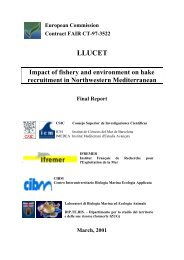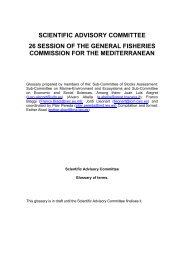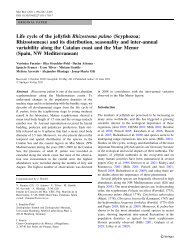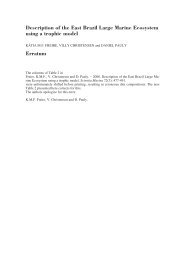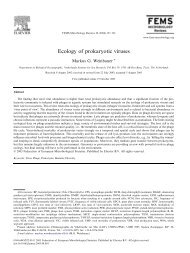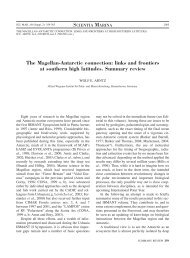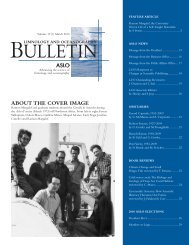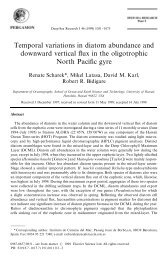REPORT OF THE WORKSHOP ON TRAWL SURVEY ... - FAO.org
REPORT OF THE WORKSHOP ON TRAWL SURVEY ... - FAO.org
REPORT OF THE WORKSHOP ON TRAWL SURVEY ... - FAO.org
Create successful ePaper yourself
Turn your PDF publications into a flip-book with our unique Google optimized e-Paper software.
placing a few tows at random within each of many small strata (e.g. ICES rectangles) has the<br />
benefit of avoiding large gaps that can occur with more tows in larger strata. This is the<br />
approach (theoretically) adopted in the North Sea IBTS. The BITS uses a randomised design<br />
with depth-related strata, with tows selected each year from a tows database. Other stratified<br />
random surveys based on larger (depth related) strata rather than small rectangles include the<br />
Faroes Plateau trawl surveys in spring and summer, the Icelandic cod surveys and the<br />
Greenland cod surveys (ICES NWWG, 2006).<br />
Some surveys use a more-or-less fixed station design, in which the same positions are fished<br />
each survey. This is more common in European surveys than in North American and<br />
Canadian surveys which tend to be stratified random. Fixed-station designs are more common<br />
in the IBTS regions with extensive areas of untrawlable ground where there may be few<br />
known tow tracks. They may often have a pseudo-random initial design, according to the<br />
availability of clear tows. In such cases, some fish species (e.g. cod) may be more associated<br />
with the rough seabed, and catches on the finer sediments may reflect changes in fish<br />
behaviour affecting movement away from the preferred habitat.<br />
Statistical aspects of survey design and analysis<br />
Survey design<br />
The WKSAD meeting in 2004 provided a wide ranging overview of methods for design and<br />
analysis of surveys taking into account the statistical properties of catch-rate data, as well as a<br />
summary of the design basis for the main North Atlantic surveys. The use of simulations to<br />
investigate a range of design-based and model-based estimation procedures for random,<br />
random-stratified and systematic surveys was investigated. The outcomes of existing studies<br />
confirmed that –<br />
- In the presence of positive local autocorrelation, a more precise estimate of the<br />
population mean will be obtained by stratified random sampling, or systematic<br />
sampling with random starting point (as in North Sea herring acoustic survey),<br />
than by simple random sampling;<br />
- Stratified random sampling will often be preferable if getting a good estimate of<br />
precision is required;<br />
- Geostatistical estimators, or random sampling with many strata but only two<br />
samples per stratum, gave the smallest 90% confidence intervals.<br />
The 2005 WKSAD meeting carried out further simulation studies using data generated by a<br />
geostatistical simulation model. Two simulated data sets were generated with high and low<br />
levels of spatial autocorrelation. Meeting participants were invited to apply different survey<br />
designs within specified operational constraints, without knowing the underlying properties of<br />
the simulated populations. These included 8 systematic designs, 7 stratified random designs<br />
and 4 other designs. The results confirmed the advantage of more systematic designs in the<br />
presence of more spatial autocorrelation, but also showed that when autocorrelation is low,<br />
random designs can perform better when using route optimisation algorithms that allow more<br />
trawl samples to be taken than in a (non-optimised) systematic survey.<br />
On the basis of the different simulation studies, WKSAD (2005) produced a valuable<br />
“decision tree” to assist in designing new surveys (Fig. 4). The WKSAD (2005) report<br />
contains a valuable Working Document by Cadigan (“Confidence intervals for trawlable<br />
abundance from random stratified bottom-trawl surveys”) that includes the effects of random<br />
selection of sites as well as the random fish capture process at a site (conventional “design-<br />
45




